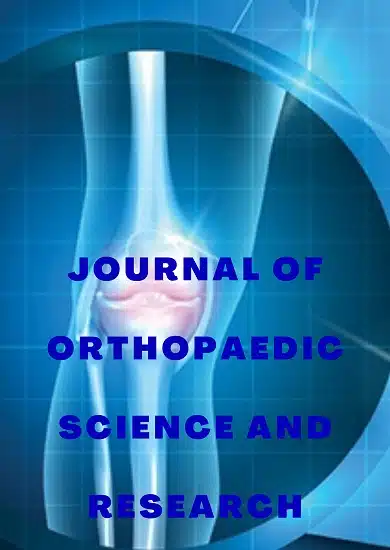Research Article | Vol. 6, Issue 1 | Journal of Orthopaedic Science and Research | Open Access |
Anterior Cruciate Ligament Reinsertion-Tensioning in Chronic Proximal Injuries Sherman I is Successful to Restore Anterior Knee Stability Case Series: Breaking A Paradigm
Manuel Mosquera1*, Iván Cárdenas2, Juan Manuel Mosquera3, David Portilla4, Jessica González PT5
1La Carolina Clinic, Bogotá, Colombia, Erasmo Clinic. Valledupar, Colombia, USA
2San Sebastián Clinic, Montería, Colombia, USA
3Cobos Clinic, Bogotá, Colombia, USA
4Erasmo Clinic, Valledupar, Colombia, USA
5Erasmo Clinic, Valledupar, Colombia, USA
*Correspondence author: Manuel Mosquera, MD, La Carolina Clinic, Bogotá, Colombia, Erasmo Clinic. Valledupar, Colombia, USA; Email: [email protected]; [email protected]
Citation: Mosquera M, et al. Anterior Cruciate Ligament Reinsertion-Tensioning in Chronic Proximal Injuries Sherman I is Successful to Restore Anterior Knee Stability Case Series: Breaking A Paradigm. J Ortho Sci Res. 2025;6(1):1-13.
Copyright© 2025 by Mosquera M, et al. All rights reserved. This is an open access article distributed under the terms of the Creative Commons Attribution License, which permits unrestricted use, distribution, and reproduction in any medium, provided the original author and source are credited.
| Received 18 February, 2025 | Accepted 13 March, 2025 | Published 20 March, 2025 |
Abstract
In the last decade there has been a growing interest in repairing acute Anterior Cruciate Ligament (ACL) tears, especially those proximal injuries with good remnants. Traditionally, the treatment of choice for these injuries and those of the middle third has been to remove the remnant or sometimes preserve it and perform a reconstruction using a tendon graft from the patient or from a bone bank. The results reported in the literature with respect to recovering stability are good and range between 85% and 95%, but also in recent years a growing number of failures due to re-rupture have been reported in all ages, especially in the population of risk that are young people under 25 years involved in contact sports. Regarding ACL repair, when the results are analyzed in Sherman I injuries, they range between 80% and 85% of good results, however there are very little reported in the literature on “repair-tensioning” the remnant when a rupture has occurred that is considered chronic due to its evolution time.
Materials and methods. A longitudinal descriptive study of a retrospective case series was carried out with 48 patients who underwent reinsertion-tensioning of the ACL in proximal Sherman I injuries whose initial injury had occurred after 3 months and with a clinical follow-up of up to 48 months with an average of 24 months. All underwent a subjective evaluation with the TEGNER and IKDC scales; and a subgroup of 31 patients, in addition to the above, underwent anterior displacement tests of the tibia measured with an arthrometer.
Results. Of 88 patients operated for chronic proximal ACL injuries (more than 3 months of injury), in a period from February 2018 to January 2022, 37 patients did not meet the inclusion criteria and 3 could not be evaluated, leaving 48 who completed the follow-upevaluation. 95% obtained a rating between good and excellent according to the TEGNER scale and 89% according to IKDC. 31 (79% of the total patients) who underwent objective measurement with an arthrometer obtained a difference of less than 2 mm with respect to the healthy knee.
Conclusion. ACL reinsertion-tensioning in chronic proximal injuries with good remnants is a viable alternative that produces good and excellent results to recover joint stability, similar to those reported when traditional reconstruction techniques are used.
Keywords: ACL Repair; ACL Tensioning; ACL Reinsertion; Sherman I
What are the new findings?
Reinsertion-tensioning ACL proximal Sherman I injuries with “good remnant” meaning, sufficient length, width and vascularization, regardless of time of injury, produces similar results compared with acute cases.
Reinsertion-tensioning ACL in chronic Sherman I injuries is an excellent option to achieve anterior knee stability, similar when you use reconstruction techniques.
Introduction
The gold standard treatment in ruptures of the Anterior Cruciate Ligament (ACL) has been in the last 40 years the reconstruction of the ligament mainly using auto- or allografts of tendon origin [1]. However, it is still controversial whether it is better to operate or treat patients with rehabilitation based on muscle strengthening and proprioceptive retraining [2,3]. In general terms, the success of ligament reconstruction ranges between 85% and 95% depending on the series [4]. However, when medium and long-term results are analyzed, these percentages decrease, especially in high-risk patients such as young people involved in contact sports activities with associated injuries of the ligaments and menisci, hyper-lax patients among others, reaching between 25% to 40% of reported failures, specifically re- ruptures [5,6].
In the 1970s it was trendy to repair anterior cruciate ligament injuries, It did not matter if they were proximal or in the middle third, the latter with disappointing results at 5 years of follow-up, which is why in the 1980s physicians stopped repairing them [7,8]. However, at that time, Weaver, Bonano and Sherman published their primary repair case series showing good results in proximal ACL injuries [9-11].
In the last 10 years, there has been a growing interest in repairing some ACL injuries, especially proximal ones classified as a Sherman I injuries, although some centers also repair middle third injuries with the help of biological scaffolds that improve healing and achieving similar results to those obtained with traditional reconstruction techniques [12-14]. Good results are also reported repairing ACL injuries using DIS™ (Dynamic Intra-ligament Stabilization), compared to the traditional reconstructive techniques [15,16].
Most of these studies have been case series with controversial results, some showing good results and some not, especially in the immature skeleton [17-19].
Part of the increase in the production of these articles reporting the results of ACL repair could be explained by unsatisfaction with the increase in failures with traditional reconstruction techniques, even though “anatomical” techniques start to be used since the beginning of this century using the pathway through the medial portal to better reproduce the femoral footprint, sometimes with the restitution of the two bundles, the antero-medial and the postero-lateral, but paradoxically reporting in some registries such as the Swedish one, a rate of failure due to re- rupture greater than with the trans-tibial technique [20].
This has also increased in recent years the addition of lateral extra-articular reconstruction techniques with a decrease in the failure rate, especially in the high- risk population [21-23].
It is logical to think that ACL repair by maintaining the original tissue has the advantages of having the original collagen, the vascular and proprioceptive microstructure and properties, the anatomical attachments, the three-dimensional shape of the ligament and its tension-relaxation capacity that any graft can’t have, however, to date the results obtained with reconstructions have not been overcome by repair in terms of stability and function, but it should be noted that the levels of osteoarthritis after ACL rupture reach alarming numbers in the long term which would suggest that, maintaining the original ACL, these numbers would decrease, a hypothesis that has not yet been proven. Even more controversial is the fact of “repair”, that is, reinsert with tensioning the remnant present when an ACL injury has occurred and a period greater than 3 months has elapsed, due to the idea that this tissue would not have the healing capacity and therefore not give stability [24-26].
Material and Methods
A retrospective longitudinal descriptive study was carried out in 48 patients with chronic proximal injury (more than 3 months) of the ACL who underwent ligament repair by reinsertion-tensioning of its fibers at the femoral site. All of them had a pre-operative and post-operative evaluation with a minimum follow-up of 12 up to 48 months and the IKDC and TEGNER evaluation scales were applied and a subgroup of 31 patients had an objective anterior displacement test with arthrometer (Lachmeter™) to measure the displacement of the operated compared to the healthy knee.
The medical records of all patients with a diagnosis of ACL rupture who underwent ACL reinsertion were reviewed.
Inclusion Criteria
Sherman type I ACL injuries of good quality with 3 months or more time injury. Symptomatic patients due to instability, who did not improve after treatment with rehabilitation.
Exclusion Criteria
Sherman II and III ACL injuries. Acute or subacute injuries.
Associated Ligament Surgery
Acute or chronic avulsions of the tibial spine. An analysis of variables such as age, gender, affected side, procedure, range of motion, complications, failure, with T tests for independent samples and specific tests such as anterior drawer, Lachman, pivot sign, before and after surgery was performed and finally a post-operative evaluation of anterior displacement of the tibia with arthrometer in the healthy and compromised knee was performed for a sub-group of patients.
Surgical Technique
The standardized surgical technique includes not using a tourniquet, use of an infusion pump and placement of a plastic working cannula through the antero- medial portal. ACL exam with a probe to detect the laxity of the ligament. (Video 1). First step is to remove the fibrosis between the remnant on the femoral wall with a dissector and a power system, avoiding damaging the tissue. (Fig. 1), (Video 2). Exposure of the ACL footprint and realization of micro-perforations in its entirety. The micro-perforations were replaced by the realization of an oval or elliptical hole made with a power system drill since 2019. (Fig. 2), (Video 3). Using automatic forceps or suture pass, taking first the postero-lateral bundle with high tension sutures twice in the form of a stitch cinch, (Fig. 3) (Video 4), making a hole with a punch above the PL bundle center, tightening the sutures and implantation of 1 anchor without knots (knotless) threaded or impacted (Fig. 4), (Video 5). Repeat the same procedure with the antero-medial bundle (Video 6) and checking the ACL double bundle tension. (Video 7). In some patients, a high-resistance tape was added following the internal brace™ concept,27 (Fig. 5) (Video 8) hanging it to the antero-medial anchor, passing it through a tunnel from the base of the ligament and coming out on the internal and superior part of the tibia and fixing it with another anchor knotless in knee extension. In cases where only one implant was used and was decided to use the Internal Brace Concept, (IBC) the suture tape was hung on it.
In all isolated reinsertion-tensioning procedures, one micro-perforation was made at the end of the procedure above the lateral inter-condylar groove to generate bleeding in order to stimulate healing. The rehabilitation program was started early to keep the knee in full extension, start isometric exercises and initiate passive and active knee flexion assisted with progressive partial support after 3 or 4 weeks. This protocol was changed to start knee flexion immediately after surgery, no matter if patient had an internal brace. Static bike was allowed after 2 months in conjunction with a strengthening muscle program. Running was initiated after 4 months. Return to sports was allowed at 6 months if patient had completed all the test battery including hop and psychological tests. Clinical evaluation was carried out at two weeks and every month for the first 12 months.
Statistic Analysis
SPSS version 15.0 for Windows was used for statistical analysis. With the parameterized Shapiro Wilk test, the assumption of normality was evaluated, yielding normality. Subsequently, variables such as age, gender, affected side, surgical procedure, surgery failure, difference with arthrometer with T tests for independent samples and specific tests such as anterior drawer, Lachman, pivot, before and after surgery were analyzed, with t tests for related samples evaluating statistical significance. Statistical significance was considered to be the relationship with P values ≤ 0.05.
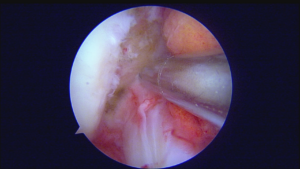
Figure 1: Fibrosis resection.
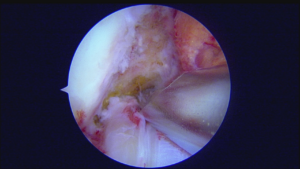
Figure 2: Foot print abrasion.
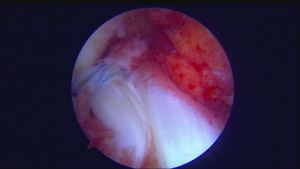
Figure 3: PL cinchs.
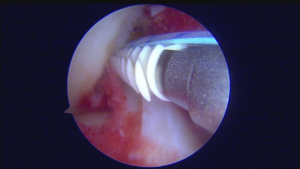
Figure 4: PL knotless implantation.
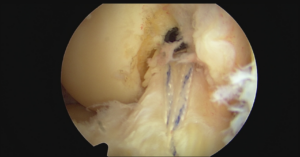
Figure 5: IB EN position.
Results
Of a total of 88 patients who underwent reinsertion-tensioning of the ACL during a period between 2018-2022, 48 patients met the inclusion criteria and accomplished to complete the evaluation follow-up as of February of 2023. All patients had a chronic injury that ranged from 3 months to a patient who underwent surgery 48 months after his injury, generating an average of 8 months. The population was characterized, finding that the male gender predominated with 52.1% and the age range was from 8 to 63 years with an average of 32 years. The limb most affected was the right with 56.3%. All patients (100%) underwent reinsertion-tensioning of the two ACL bundles, anteromedial and posterolateral. Of these 48 patients, 2 Knotless were used in 68.8% of all patients and 1 Knotless in 31.3%. In addition, Internal Brace Concept ™(IBC) was performed on 31.3% of those operated on. No significant difference was found in terms of stability and displacement measured by the arthrometer if 1 or 2 knotless were used and no difference was found in those who received IB either.
In Table 1 we show the complications associated with surgery where 2 patients (4%) had surgery failure due to traumatic re-rupture, requiring surgical reintervention and who underwent primary reconstruction, both with excellent evolution. Another 2 patients (4%) had deep infection requiring surgical washes that did not affect the ligament; one of these patients had joint stiffness (arthrofibrosis) and the other evolved satisfactorily. 1 patient had a bleeding that needed arthroscopic treatment. 2 patients (4%) presented extension pain that did not yield to physical therapy or infiltrations and required arthroscopy, finding an inflammatory tissue that produced localized impingement, one in the roof of the femoral groove and the other in the base of the ligament with resolution of symptoms after tissue removal.
Frequency | Percentage | Valid Percentage | Accumulated Percentage | |
NO | 41 | 85.4 | 85.4 | 85.4 |
Reintervention due for failure | 2 | 4.2 | 4.2 | 89.6 |
Deep Infection | 2 | 4.2 | 4.2 | 93.8 |
Bleeding | 1 | 2.1 | 2.1 | 95.8 |
Knee pain | 2 | 4.2 | 4.2 | 100.0 |
Total | 48 | 100.0 | 100.0 |
Table 1: Complications.
The patients had a minimum follow-up of 12 months and a maximum follow-up of 48 months for an average of 24 months. The patients were evaluated subjectively, pre and post operatory, showing that 100% of the patients were qualified between fair and bad according to the two scales and evaluation post-op showed that 95% of the patients obtained good and excellent grades according to TEGNER and 89% had grades between A and B according to IKDC, as can be seen in Table 2-5.
Frequency | Percentage | Valid Percentage | Accumulate Percentage | ||
Valid | FAIR | 24 | 50,0 | 50,0 | 50,0 |
BAD | 24 | 50,0 | 50,0 | 100,0 | |
Total | 48 | 100,0 | 100,0 |
Table 2: Initial tegner.
| Frequency | Percentage | Valid Percentage | Accumulate Percentage |
EXCELLENT | 35 | 72.9 | 72.9 | 72.9 |
GOOD | 10 | 20.8 | 20.8 | 93.8 |
FAIR | 2 | 4.2 | 4.2 | 97.9 |
BAD | 1 | 2.1 | 2.1 | 100.0 |
Total | 48 | 100.0 | 100.0 |
Table 3: Final tegner.
Frequency | Percentage | Valid Percentage | Accumulate Percentage | |||
Válid | FAIR | 7 | 14,6 | 14,6 | 14,6 | |
BAD | 41 | 85,4 | 85,4 | 100,0 | ||
Total | 48 | 100,0 | 100,0 | |||
Table 4: Initial IKDC.
Frequency | Percentage | Valid Percentage | Accumulate Percentage | |
EXCELLENT | 23 | 47.9 | 47.9 | 47.9 |
GOOD | 15 | 31.3 | 31.3 | 79.2 |
FAIR | 8 | 16.7 | 16.7 | 95.8 |
Table 5: Final IKDC.
In Table 6, a comparison was made of pre and post-surgical evaluation of TEGNER and IKDC subjective test, where improvement of the patients were evident with statistical significance.
Media | Standard Deviation | P factor | P of Two Factors | |
Par 1 INITIAL TEGNER_ FINAL TEGNER _ | 2,16667 | ,66311 | <,001 | <,001 |
Par 2 IKDC_INICIAL – IKDC_FINAL | 2,27083 | ,76463 | <,001 | <,001 |
Table 6: Comparison of initial versus final subjective scales.
An objective evaluation was carried out on 31 of the 48 patients with the arthrometer where both knees, the healthy and the operated one, were evaluated and the difference between the two was obtained, observing that all of 31 patients (100%) had a difference of less than 2 mm in displacement, as evidenced in Table 7.
Millimeters | Frequency | Percentage | Valid Percentage | Accumulate Percentage |
1.00 | 20 | 57.1 | 57.1 | 57.1 |
2.00 | 11 | 42.9 | 42.9 | 100 |
3.00 | 0 | 0 | 0 | 100.0 |
Total | 31 | 100.0 | 100.0 |
Table 7: Arthrometer differences.
Table 8 describes the related tests (before and after the surgical procedure).
Statistical significance was evidenced for the Lachman, anterior drawer and pivot tests
|
| Related Differences | ||
Average | Standard Deviation | Sig. (bilateral) | ||
Lachman Pre – Lachman Pop. | 1.81250 | 0.53221 | 0.00 | |
Anterior Drawer Pre. AD Pop. | 1.41667 | 0.61310 | 0.00 | |
Pivot Pre – Pivot Pop. | 0.22917 | 0.59213 | 0.010 | |
Pre: pre-surgical Pop: post-surgical Statistical significance must be ≤ 0.05 | ||||
Table 8: Related tests.
Discussion
Currently, the gold standard for surgical treatment of ACL injuries continues to be ligament reconstruction, removing the original tissue and replacing it with a tendon autograft or allograft. However, it is evident that in the last 10 years, growing interest has arisen to preserve and or repair mainly Sherman I injuries, that is, those that are not separated more than 0.5 to 1 centimeter (cm) from the femoral footprint, using high-tension sutures and different implants, fixed to the lateral femoral condyle and in some cases these repairs have been augmented with ultra-resistant tapes, following the concept of the Internal Brace™ (IBC) or with biological tendon-type grafts showing good results similar to traditional reconstruction techniques at 5 years of follow-up [28-33].
Most of the papers published with ACL repair are cases series carried out in patients with acute injuries defined as those that have occurred no more than two months after surgery, even though the concept is ambiguous in the literature, when an acute injury becomes chronic.
It has been suggested in the literature that only acute injuries should be repaired because the vitality of the remnant is ensured and because of the ability to heal in the bone and that the ligament itself does not atrophy and can fulfill its stabilizing function.
When cases of primary repair in the acute phase of Sherman I injuries have been included, the results are generally close to those obtained with ligament reconstruction techniques, which range between 85% and 90% with follow-ups of less than 5 years [34,35].
Van der List, et al., in a case series study, included 69 patients, of whom 34 (49%) underwent primary repair before 3 weeks post-injury and 35 patients (51%) underwent repair 3 months after the injury with a 2-year follow-up and did not find differences in their good results, highlighting that more important than the time is the quality of the remnant [36].
All 48 patients in this study had had an ACL injury of more than 3 months. The results found in our work are in agreement with the results of Van der List, taking into account that, regardless of the time of injury, we obtained results between good and excellent in 95% according to the TEGNER subjective scale and 89% according to the IKDC subjective scale. For the senior author (MMA), the most relevant factor to consider when a chronic tensioning is indicated is that the quality and length of the tissue to allow reinsertion, as expressed in their article by doctors Vermeijden, et al., in where by resonance study they found a positive predictive value of reparability of 94% in injuries of the proximal third [37].
Murray, et al., have reported similar results to ligament reconstruction in acute Sherman II and III injuries, using biological scaffolds that enhance the ligament’s healing capacity, results that allow us to open the range of therapeutic possibilities in this type of injury [38]. Accomplishing preservation of the original tissue and restoring the biomechanical capacity of the ligament stabilization, without the co-morbidities and complications reported using tendon grafts, would mean a radical change in the modern treatment of ACL injuries.
Some studies comparing primary repair versus reconstruction in type I injuries are already underway and others compare it retrospectively with similar results [39-41].
This study constitutes the largest series published in patients who underwent reinsertion-tensioning in the chronic scenario with 48 patients, with good results on average at 2 years of follow-up. We believe that the fundamental reason for obtaining these results lies in the strict selection of each case to indicate the procedure, that is, a remnant in good conditions of length, diameter and vascular structure, added to a refined surgical technique with a rehabilitation program synchronized with the ligament healing phases. In cases where the diameter of the remnant in the tibial insertion was smaller than the original, a tendon autograft was always added following the I.B.C™ concept, results of which will be the subject of another publication.
Since 2019, the addition of a tape to the ACL repair was included, which was hung from the knotless implant from the Anteromedial (AM) bundle in case of using two implants or the only one, without competing in tension with the sutures of the remnant, placed anterior to the ligament and also fixed in extension at the end of the procedure, in the medial and proximal tibia. The criteria we used to add the synthetic I.B.C™, was for young patients with expectations of an early return to sports or patients who, due to their condition, it was intuited that they were not going to follow a strict adherence to the rehabilitation protocol [42]. In the literature there are several biomechanical and clinical studies related to the addition of the I.B.C and the possible advantages in terms of mechanical stability and the protective role of the repair, compared to isolated reinsertions which, although controversial, incline the balance towards its use in a certain group of patients [43,44]. In our study, due to not having randomized them from the beginning, we cannot give conclusions, however, in our results we did not find differences that suggest us to indicate it in all patients [45,46].
There are some relevant aspects that are worth discussing with respect to the study and they are: the sutures used and type of repair, the surgical technique, the implant used and the rehabilitation and sports return program:
- In all cases, the sutures used were high tension number 2 in diameter, with very few cases using 2-0 sutures and never using absorbable sutures, all passed through the tissue in the form of a cinch, taking each bundle, with automatic forceps or passers at the proximal end, with one and a half sutures (3 strands) or two sutures (4 strands) for each Anteromedial (AM) and Posterolateral (PL) bundle. Different types of stitches have been described, all with some advantages and disadvantages, that is, single, continuous single, double, straps, etc. In our study we always used the cinch stitch because it has good resistance to traction-tension avoiding tearing the tissue. Also, it allows the suture to slide a few millimeters, so when it is tightened and fixed with the implant to the femur, it stays very close to the bone and diminishes the possibility of generating foreign body reactions into the joint
- The surgical technique demands a careful dissection of the remnant with instruments that do not damage the tissue, such as dissectors or small motorized blades, always placed on the opposite side of the tissue to avoid its damage. As far as possible, we do not dissect the fibrous tissue attached to the femoral wall or on the synovial wall of the Posterior Cruciate Ligament (PCL) with radiofrequency, to avoid shrinking the tissue, burning the edges and affecting the healing process. Only these heat-generating instruments are used above the footprint to clear the bone. In all cases, the femoral ACL footprint is exposed by identifying the lateral inter-condylar groove or resident’s groove, which is the upper limit (or anterior in a knee at 90 degrees of flexion) and it is debrided by making micro-perforations to stimulate bleeding and promote healing of the remnant in its original insertion site. Since 2019, micro-fractures have been replaced by making an oval footprint with a depth of 2-3 mm made with a burr placed in the power system
- Different implants have been used to fix the sutures and therefore reinsert and tighten the remnant, from adjustable buttons to anchors with sutures and knots and anchors without knots (knotless), all showing good tensile strengths. However, in our opinion and experience, knotless implants make it possible to generate greater tension in the remnant tissue, an effect that can lead to over tension and which, to date, according to our results, has not led us to believe that it has a negative effect on healing or on generating a re-rupture. On the contrary, in cases in which a second look has been carried out for reasons other than failure, it has been noted that the strain gives way like any biological tissue that is subjected to a load “accommodating” to what nature demands. One of the most relevant clinical findings in our study was the abolition of the Lachman’s and the anterior drawer in the clinical evaluation, objectively reflected in the measured anterior displacement tests. All of the patient 31 patients evaluated with the arthrometer had a difference of 2 mm or less. The knotless anchor implant also has the versatility of occupying a small space, allowing the use of two around of the footprint, which, being plastic, do not interfere with magnetic resonance for further evaluation imaging and finally also allow a tape to be hung to use the principle of the Internal Brace Concept™ (I.B.C), without competing bio-mechanically with the sutures and the remnant tissue
- All first patients were placed in a postoperative immobilizer for the first few days and they were early instructed to keep the knee in extension, start quadriceps isometrics, immediately support with crutches and start passive and active prone flexion assisted from the 3rd-4th As of 2020, this protocol was changed to start immediate mobility, in ranges from 0 to 45 degrees the first two weeks and from 45 to 90 from the third week, without making a difference if they had added an Internal Brace™ (IB). This change in the protocol occurred for two reasons: even though the patient’s mobility was restricted, when he returned to control after fifteen (15) days, he had voluntarily started his mobility without this affecting the knee stability and also because when we delayed the start of flexion, the patients had greater pain, more time to recover the range of motion and muscle strength [47]. The fact that the described technique generates less pain and inflammation automatically causes the patient to recover muscle control and gain mobility quickly and in all patients except one, flexion-extension was achieved after 6 weeks. This advantage of lower morbidity also worked against us with a patient who, without permission, at the fourth month after surgery, felt herself ready to return to her sports, presenting a torsional trauma 5 months after surgery, tearing the re-inserted anterior cruciate ligament. This patient was taken to surgery performing a “primary” reconstruction with an autograft. From this case, the internal splint was added to all high-risk patients, with expectations of sports return in pivot activities [48]. Irfan, et al., recommend a 6-phase rehabilitation protocol that includes Return To Sport (RTS) after 12 months [49]. At present, RTS has slowed down when we do reconstruction of the ACL, taking into account the high failure due to re-rupture of the graft, especially in high-risk patients. We not only take into account the time, which is generally accepted today that should not be less than nine (9) months, but we also evaluate in a more objective way the psychological and physical state of the patient with different tests that have already been validated to reduce the risk of re-injury. Unfortunately, there is very little written about healing, rehabilitation and return to sports when we do an ACL reinsertion-tensioning. Attempts are being made to standardize the signs of ACL healing by means of resonance as has been done with reconstruction techniques, but to date we have not been able to have findings that confirm that a reinserted ligament has already healed in the bone and how it did50. When graft healing is evaluated, it is done both between the tunnel- graft interface and in its intra-articular portion with defined patterns, although these are currently controversial. In terms of repair, we are not sure what to evaluate, if only the ligament-bone interface or also the entire ligament as such. Nevertheless, what we must take into account is that the healing phases of the graft-bone and the ligament-bone can be very similar and happen in 3 or 4 months, which would mean that, in repair, we would have the theoretical advantage of being able to return our patients earlier, taking into account that the healing-maturation phase that a graft goes through does not occur in this case. In our experience, the patient undergoing a repair, if after 6 months passes the psychological and physical tests, is able to return, which does not happen with a graft that at 6 months has its “ligamentization” process still developing even if the patient is ready to return
- Two patients presented deep post-surgery infection, which was diagnosed and treated 15 days after the procedure with washes and antibiotics. During the washes it was observed that the ligament maintained its tension and vascularity and both cases at the end of the evaluation had a good result in terms of stability. The opposite happens when an infection is diagnosed after two weeks in a reconstructive surgery using grafts, where it is often necessary to remove the graft because it already constitutes a focus that makes the secretion and infection last. Colleagues who do not believe in ACL repair argue that surely those patients with Sherman I injuries would have done well with non-surgical treatment and they may be right not only for proximal ruptures but for any rupture. However, all our patients completed a rehabilitation program that had been unsuccessful, therefore we always operated symptomatic patients
Conclusion
We consider that the results obtained in our study are highly satisfactory in terms of recovering joint stability in Sherman I injuries regardless of the time of evolution and with the described surgical technique. When the results of the subjective evaluations of the IKDC scale in our patients were analyzed, we found that some had fair qualifications because this scale assess, among others, postoperative pain in various situations of daily life, such as going up and down stairs, sitting, kneeling, jumping, etc, which could be explained because in a considerable number of our patients the origin of the trauma was a labor accident, perhaps seeking some type of compensation for them. On the other hand, we must highlight that 31 (100%) of the patients evaluated with the arthrometer had a difference equal to or less than 2 mm with respect to their healthy knee, which indicates how successful this technique is in stabilizing the knee. Future prospective studies of repair versus reconstruction in Sherman I ACL tears should recommend us the best option to treat this injury, especially in the high-risk patient who is our sword of Damocles nowadays.
Conflict of Interests
The authors declare that they have no conflict of interest in this paper.
Funding/Sponsorship
Not applicable
References
- Frobell RB, Roos EM, Roos HP, Ranstam J, Lohmander LS. A randomized trial of treatment for acute anterior cruciate ligament tears. New Eng J Medicine. 2010;363(4):331-42.
- Smith TO, Postle K, Penny F, McNamara I, Mann CJ. Is reconstruction the best management strategy for anterior cruciate ligament rupture? A systematic review and meta-analysis comparing anterior cruciate ligament reconstruction versus non-operative treatment. The Knee. 2014;21(2):462-70.
- Fu FH, Bennett CH, Ma CB, Menetrey J, Lattermann C. Current trends in anterior cruciate ligament reconstruction: Part II. Operative procedures and clinical correlations. The Am J Sports Medicine. 2000;28(1):124-30.
- Barber-Westin S, Noyes FR. One in 5 athletes sustain reinjury upon return to high-risk sports after ACL reconstruction: A systematic review in 1239 athletes younger than 20 years. Sports Health. 2020;12(6):587-97.
- Wiggins AJ, Grandhi RK, Schneider DK, Stanfield D, Webster KE, Myer GD. Risk of secondary injury in younger athletes after anterior cruciate ligament reconstruction: A systematic review and meta-analysis. The Am J Sports Medicine. 2016;44(7):1861-76.
- England RL. Repair of the ligaments about the knee. Orthop Clin North Am. 1976;7:195-204.
- Feagin JA, Curl WW. Isolated tear of the anterior cruciate ligament: 5-year follow-up study. Am J Sports Med. 1976;4:95-100.
- Weaver JK, Derkash RS, Freeman JR, Kirk RE, Oden RR, Matyas J. Primary knee ligament repair-revisited. Clinical Orthopaedics and Related Research®. 1985;199:185-91.
- Sherman MF, Bonamo JR. Primary repair of the anterior cruciate ligament. Clin Sports Med. 1988;7:739-50.
- MF S. The long-term follow-up of primary anterior cruciate ligament repair. Am J Sports Med. 1991;19:458-61.
- DiFelice GS, Villegas C, Taylor S. Anterior cruciate ligament preservation: Early results of a novel arthroscopic technique for suture anchor primary anterior cruciate ligament repair. Arthroscopy: The Journal of Arthroscopic and Related Surgery. 2015;31(11):2162-71.
- MacKay G, Anthony IC, Jenkins PJ, Blyth M. Anterior cruciate ligament repair revisited. Preliminary results of primary repair with internal brace ligament augmentation: A case series. Orthop Muscul Syst. 2015;4(2):1-5.
- Murray MM, Fleming BC. Use of a bioactive scaffold to stimulate anterior cruciate ligament healing also minimizes posttraumatic osteoarthritis after surgery. The Am J Sports Medicine. 2013;41(8):1762-70.
- Hoogeslag RA, Brouwer RW, Boer BC, de Vries AJ, Huis in ‘t Veld R. Acute anterior cruciate ligament rupture: repair or reconstruction? Two-year results of a randomized controlled clinical trial. The Am J Sports Medicine. 2019;47(3):567-77.
- Malahias MA, Chytas D, Nakamura K, Raoulis V, Yokota M, Nikolaou VS. A narrative review of four different new techniques in primary anterior cruciate ligament repair:“back to the future” or another trend?. Sports Medicine-Open. 2018;4:1-2.
- Hoffmann C, Friederichs J, von Rüden C, Schaller C, Bühren V, Moessmer C. Primary single suture anchor re-fixation of anterior cruciate ligament proximal avulsion tears leads to good functional mid-term results: a preliminary study in 12 patients. J Orthop Surg Res. 2017;12(1): 171.
- Achtnich A, Rosslenbroich S, Beitzel K, Imhoff AB, Petersen W. Arthroscopic refixation of acute proximal anterior cruciate ligament rupture using suture anchors. Oper Orthop Traumatol. 2017; 29(2):173-9.
- Vermeijden HD, Yang XA, van der List JP, DiFelice GS. Role of age on success of arthroscopic primary repair of proximal anterior cruciate ligament tears. Arthroscopy. The J Arthroscopic and Related Surgery. 2021;37(4):1194-201.
- Desai N, Andernord D, Sundemo D, Alentorn-Geli E, Musahl V, Fu F, et al. Revision surgery in anterior cruciate ligament reconstruction: a cohort study of 17,682 patients from the Swedish National Knee Ligament Register. Knee Surgery, Sports Traumatology, Arthroscopy. 2017;25:1542-54.
- Sonnery-Cottet B, Haidar I, Rayes J, Fradin T, Ngbilo C, Vieira TD, et al. Long-term graft rupture rates after combined ACL and anterolateral ligament reconstruction versus isolated ACL reconstruction: A matched-pair analysis from the SANTI Study Group. The Am J Sports Medicine. 2021;49(11):2889-97.
- Ariel de Lima D, de Lima LL, de Souza NG, de Moraes Perez RA, Sobrado MF, Guimarães TM, et al. Clinical outcomes of combined anterior cruciate ligament and anterolateral ligament reconstruction: a systematic review and meta-analysis. Knee Surgery and Related Research. 2021;33:1-4.
- Beckers L, Vivacqua T, Firth AD, Getgood AM. Clinical outcomes of contemporary lateral augmentation techniques in primary ACL reconstruction: a systematic review and meta-analysis. J Experimental Orthopaedics. 2021;8(1):59.
- Luc B, Gribble PA, Pietrosimone BG. Osteoarthritis prevalence following anterior cruciate ligament reconstruction: A systematic review and numbers-needed-to-treat analysis. J Athletic Training. 2014;49(6):806-19.
- Ajuied A, Wong F, Smith C, Norris M, Earnshaw P, Back D, et al. Anterior cruciate ligament injury and radiologic progression of knee osteoarthritis: a systematic review and meta-analysis. The Am J Sports Medicine. 2014;42(9):2242-52.
- Jones MH, Spindler KP. Risk factors for radiographic joint space narrowing and patient reported outcomes of post‐traumatic osteoarthritis after ACL reconstruction: data from the MOON cohort. J Orthopaedic Res. 2017;35(7):1366-74.
- Heusdens CH, Hopper GP, Dossche L, Roelant E, Mackay GM. Anterior cruciate ligament repair with independent suture tape reinforcement: a case series with 2-year follow-up. Knee Surgery, Sports Traumatology, Arthroscopy. 2019;27:60-7.
- Muench LN, Berthold DP, Archambault S, Slater M, Mehl J, Obopilwe E, et al. Anterior cruciate ligament (ACL) repair using cortical or anchor fixation with suture tape augmentation vs ACL reconstruction: A comparative biomechanical analysis. The Knee. 2022;34:76-88.
- Smith PA, Cook CS. Knotless primary anterior cruciate ligament repair with adjustable loop device and internal brace augmentation. Arthroscopy Techniques. 2020;9(12):e1967-75.
- Zhao L, Lu M, Deng M, Xing J, Xu T. Arthroscopy primary double-bundle repair of anterior cruciate ligament with internal brace augmentation and a knotless anchor implant. Arthroscopy Techniques. 2020;9(12):e1927-35.
- Vermeijden HD, van der List JP, DiFelice GS. Arthroscopic primary repair of the anterior cruciate ligament with single-bundle graft augmentation. Arthroscopy Techniques. 2020;9(3):e367-73.
- Fayard JM, Penet A, Bauwens PH, Thaunat M. Combined anterior cruciate ligament repair and anterolateral ligament reconstruction with a single-strand gracilis graft. Arthroscopy Techniques. 2021;10(11):e2607-17.
- Hopper GP, Aithie JM, Jenkins JM, Wilson WT, Mackay GM. Satisfactory patient‐reported outcomes at 5 years following primary repair with suture tape augmentation for proximal anterior cruciate ligament tears. Knee Surgery, Sports Traumatology, Arthroscopy. 2022;30(1):253-9.
- Vermeijden HD, van der List JP, O’Brien RJ, DiFelice GS. Primary repair of anterior cruciate ligament injuries: current level of evidence of available techniques. JBJS Reviews. 2021;9(5):e20.
- Van der List JP, Vermeijden HD, Sierevelt IN, DiFelice GS, van Noort A, Kerkhoffs GMMJ. Arthroscopic primary repair of proximal anterior cruciate ligament tears seems safe but higher level of evidence is needed: A systematic review and meta-analysis of recent literature. Knee Surg. Sports Traumatol Arthrosc. 2020;28(6):1946-57.
- Vermeijden HD, van Der List JP, DiFelice GS. Acute and delayed anterior cruciate ligament repair results in similar short to mid-term outcomes. The Knee. 2021;29:142-9.
- Vermeijden HD, Cerniglia B, Mintz DN, Rademakers MV, Kerkhoffs GM, van der List JP, et al. Distal remnant length can be measured reliably and predicts primary repair of proximal anterior cruciate ligament tears. Knee Surgery, Sports Traumatology, Arthroscopy. 2021;29:2967-75.
- Barnett SC, Murray MM, Badger GJ, Bear Trial Team, Sanborn R, Kiapour A, et al. Earlier resolution of symptoms and return of function after bridge-enhanced anterior cruciate ligament repair as compared with anterior cruciate ligament reconstruction. Orthopaedic J Sports Medicine. 2021;9(11):23259671211052530.
- Van der List JP, Vermeijden HD, Sierevelt IN, Rademakers MV, Falke MLM, Helmerhorst GTT, et al. Repair versus reconstruction for proximal anterior cruciate ligament tears: a study protocol for a prospective multicenter randomized controlled trial. BMC Musculoskelet Disord. 2021;22(1):399.
- Boer BC, Hoogeslag RA, Brouwer RW, Demmer A, Huis in‘t Veld RM. Self-reported functional recovery after reconstruction versus repair in acute anterior cruciate ligament rupture (ROTOR): a randomized controlled clinical trial. BMC Musculoskeletal Disorders. 2018;19:1-7.
- Szwedowski D, Paczesny Ł, Zabrzyński J, Gagat M, Domżalski M, Huri G, et al. The comparison of clinical result between primary repair of the anterior cruciate ligament with additional internal bracing and anatomic single bundle reconstruction – A retrospective study. J Clin Med. 2021;10(17):3948.
- Hopper GP, Aithie JM, Jenkins JM, Wilson WT, Mackay GM. Combined anterior cruciate ligament repair and anterolateral ligament internal brace augmentation: minimum 2-year patient-reported outcome measures. Orthopaedic J Sports Medicine. 2020;8(12):2325967120968557.
- Bachmaier S, DiFelice GS, Sonnery-Cottet B, Douoguih WA, Smith PA, Pace LJ, et al. Treatment of acute proximal anterior cruciate ligament tears—Part 2: The role of internal bracing on gap formation and stabilization of repair techniques. Orthopaedic J Sports Medicine. 2020;8(1):2325967119897423.
- Heusdens CHW, Hopper GP, Dossche L, Roelant E, Mackay GM. Anterior cruciate ligament repair with Independent Suture Tape Reinforcement: A case series with 2-year follow-up. Knee Surg Sports Traumatol Arthrosc. 2019;27(1):60-67.
- Qin C, Kahn A, Amirouche F, Beltagi A, Pradhan S, Koh JL, et al. Suture Tape Augmentation Has No Effect on Anterior Tibial Translation, Gap Formation or Load to Failure of Anterior Cruciate Ligament Repair: A Biomechanical Pilot Study. Arthrosc Sports Med Rehabil. 2021; 3(1).
- Van der List JP, DiFelice GS. Gap formation following primary repair of the anterior cruciate ligament: A biomechanical evaluation. Knee. 2017;24(2):243-9.
- Vermeijden HD, van der List JP, O’Brien R, DiFelice GS. Patients forget about their operated knee more following arthroscopic primary repair of the anterior cruciate ligament than following reconstruction. Arthroscopy. 2020;36(3):797-804.
- Wu J, Kator JL, Zarro M, Leong NL. Rehabilitation principles to consider for anterior cruciate ligament repair. Sports Health. 2021.
- Irfan A, Kerr S, Hopper G, Wilson W, Wilson L, Mackay G. A criterion based rehabilitation protocol for ACL repair with internal brace augmentation. Int J Sports Physical Therapy. 2021;16(3):870.
- Vermeijden HD, Van der List JP, O’Brien R, DiFelice GS. Return to sports following arthroscopic primary repair of the anterior cruciate ligament in the adult population. Knee. 2020;27(3):906-14.
Author Info
Manuel Mosquera1*, Iván Cárdenas2, Juan Manuel Mosquera3, David Portilla4, Jessica González PT5
1La Carolina Clinic, Bogotá, Colombia, Erasmo Clinic. Valledupar, Colombia, USA
2San Sebastián Clinic, Montería, Colombia, USA
3Cobos Clinic, Bogotá, Colombia, USA
4Erasmo Clinic, Valledupar, Colombia, USA
5Erasmo Clinic, Valledupar, Colombia, USA
*Correspondence author: Manuel Mosquera, MD, La Carolina Clinic, Bogotá, Colombia, Erasmo Clinic. Valledupar, Colombia, USA; Email: [email protected]; [email protected]
Copyright
Manuel Mosquera1*, Iván Cárdenas2, Juan Manuel Mosquera3, David Portilla4, Jessica González PT5
1La Carolina Clinic, Bogotá, Colombia, Erasmo Clinic. Valledupar, Colombia, USA
2San Sebastián Clinic, Montería, Colombia, USA
3Cobos Clinic, Bogotá, Colombia, USA
4Erasmo Clinic, Valledupar, Colombia, USA
5Erasmo Clinic, Valledupar, Colombia, USA
*Correspondence author: Manuel Mosquera, MD, La Carolina Clinic, Bogotá, Colombia, Erasmo Clinic. Valledupar, Colombia, USA; Email: [email protected]; [email protected]
Copyright© 2025 by Mosquera M, et al. All rights reserved. This is an open access article distributed under the terms of the Creative Commons Attribution License, which permits unrestricted use, distribution, and reproduction in any medium, provided the original author and source are credited.
Citation
Citation: Mosquera M, et al. Anterior Cruciate Ligament Reinsertion-Tensioning in Chronic Proximal Injuries Sherman I is Successful to Restore Anterior Knee Stability Case Series: Breaking A Paradigm. J Ortho Sci Res. 2025;6(1):1-13.

